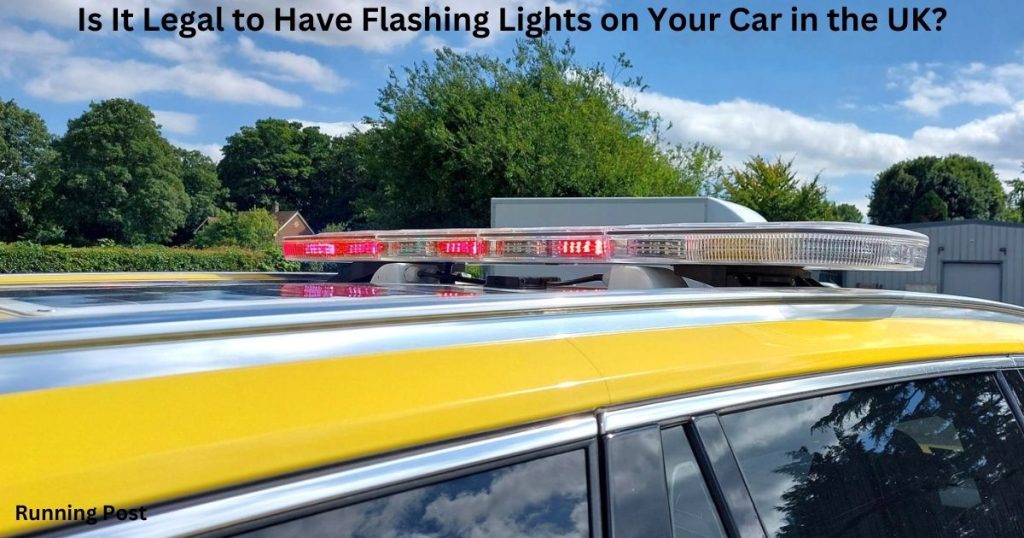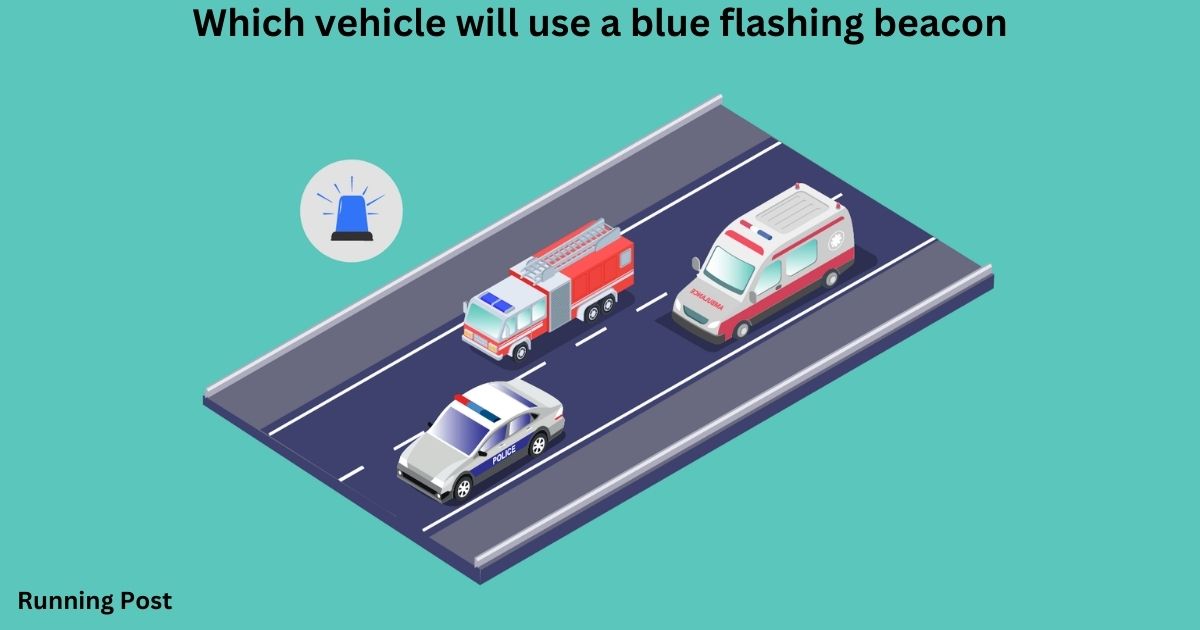| A: Delivery Vans | B: Personal Vehicles | C: Emergency vehicles | D: Tourist Buses |
Understanding Blue Flashing Beacons on Vehicles
What Does a Blue Flashing Light on a Vehicle Mean?
A blue flashing light on a vehicle is crucial for signaling emergency situations. It’s used primarily by emergency services such as police, ambulances, and fire trucks to alert other road users of their urgent presence. The blue light enhances the vehicle’s visibility, ensuring it can navigate through traffic quickly and safely.
- Signal for Emergency: Blue lights indicate the vehicle is responding to an urgent call, requiring immediate clearance from other drivers.
- Traffic Navigation: It helps emergency vehicles maneuver through traffic more effectively.
- Regulation Compliance: Only authorized emergency vehicles are permitted to use blue lights to prevent misuse and confusion.
Explanation: The blue flashing light acts as a beacon for immediate action from other road users, ensuring that emergency vehicles can reach their destinations without delay. It’s a regulated signal designed to maintain road safety and efficiency in critical situations.
Purpose of Blue Flashing Lights
The purpose of blue flashing lights is to make emergency vehicles highly visible and to command attention. These lights are designed to be seen from a distance and cut through traffic, alerting other drivers to make way. The flashing pattern is distinctive, making it easy to recognize and respond to.
- Enhanced Visibility: Blue lights ensure that emergency vehicles are visible even in challenging conditions like fog or heavy traffic.
- Attention-Grabbing: The flashing pattern attracts drivers’ attention, signaling the need to yield.
- Urgency Signaling: The distinct color and pattern communicate an immediate need for other drivers to clear the way.
Explanation: Blue lights are essential for ensuring that emergency vehicles can move through traffic quickly and safely. Their visibility and distinctive flashing pattern are critical for maintaining the efficiency of emergency responses.
Who Can Use Blue Lights in the UK?
In the UK, blue lights are restricted to specific types of vehicles to ensure their effectiveness and prevent misuse. Authorized users include emergency services like police, ambulances, and fire services, as well as specialized vehicles like bomb disposal units.
- Police Vehicles: Use blue lights to respond to emergencies and enforce the law.
- Ambulances: Equipped with blue lights to quickly reach medical emergencies.
- Fire Services: Use blue lights to access fire scenes and rescue operations.
- Specialized Vehicles: Bomb disposal units also use blue lights for their critical tasks.
Explanation: The restricted use of blue lights ensures that only authorized vehicles can use them, maintaining their significance in emergency situations. This regulation helps to avoid confusion and ensures that blue lights retain their role in signaling urgent situations.
Emergency Services
Police Vehicles
Police vehicles use blue flashing lights to indicate their presence and authority. This helps them navigate through traffic while responding to emergencies or conducting law enforcement activities.
- Law Enforcement: Blue lights assist in managing traffic during police operations.
- Emergency Response: Enables quick access to crime scenes or incidents.
- Visibility: Helps police vehicles stand out in busy traffic.
Explanation: Blue lights on police vehicles are essential for ensuring they can perform their duties efficiently, particularly in high-pressure situations where quick movement is crucial.
Ambulances
Ambulances use blue flashing lights to expedite their journey to medical emergencies. The blue light alerts other drivers to give way, allowing ambulances to reach patients swiftly.
- Medical Emergencies: Blue lights facilitate urgent medical responses.
- Traffic Management: Ensures other drivers clear the path for ambulances.
- Public Awareness: Alerts the public to the presence of a critical medical vehicle.
Explanation: The use of blue lights on ambulances is vital for providing timely medical care, as they help ambulances navigate through traffic without unnecessary delays.
Fire Services
Fire services use blue flashing lights to reach fire scenes and perform rescue operations efficiently. The blue light helps to clear traffic and improve response times during emergencies.
- Fire Response: Quick access to fire incidents and emergencies.
- Traffic Clearance: Ensures that fire trucks can navigate through congested areas.
- Operational Efficiency: Enhances overall effectiveness in emergency situations.
Explanation: Blue lights on fire service vehicles are crucial for their rapid response to fires and emergencies, helping them manage traffic and reach their destinations promptly.
Specialized Vehicles
Bomb Disposal Units
Bomb disposal units use blue flashing lights to signal their urgent and specialized role in handling explosive threats. This ensures their safety and expedites their response to potentially dangerous situations.
- Explosive Threats: Blue lights indicate the presence of bomb disposal teams.
- Safety Measures: Helps secure the area and manage traffic around bomb disposal operations.
- Specialized Role: Highlights the unique and critical nature of their work.
Explanation: Blue lights on bomb disposal units are essential for their safety and operational efficiency, ensuring they can handle explosive threats swiftly and safely.
Other Authorised Vehicles
Other vehicles authorized to use blue lights might include certain government and emergency response vehicles that perform specialized roles.
- Government Vehicles: Some may use blue lights for official duties.
- Emergency Responders: Includes various specialized units.
- Regulation Adherence: Must comply with specific regulations for blue light use.
Explanation: The use of blue lights by other authorized vehicles is regulated to maintain clarity and prevent misuse, ensuring that blue lights remain a reliable signal for emergency situations.
You Also Like It:
How would under-inflated tyres affect your vehicle?
Which driving technique can help you save fuel?
What Type of Vehicle Must Use a Flashing Amber Beacon on This Road?
Flashing amber beacons are used on vehicles to indicate caution and to alert other drivers of potential hazards. These beacons are commonly found on road maintenance, slow-moving, and utility vehicles.
- Road Maintenance Vehicles: Use amber beacons to signal work in progress and ensure safety.
- Slow-Moving Vehicles: Amber lights alert other drivers to vehicles traveling below normal speeds.
- Construction and Utility Vehicles: Flashing amber beacons indicate the presence of vehicles involved in construction or utility work.
Explanation: Flashing amber beacons help to improve road safety by alerting drivers to potential hazards and ensuring that vehicles involved in maintenance or construction are visible.
Purpose of Amber Beacons
Amber beacons serve to signal caution and provide visibility for vehicles engaged in activities that could affect traffic flow or safety.
- Visibility Enhancement: Amber beacons increase the visibility of vehicles in low-light or poor weather conditions.
- Caution Indication: Alerts drivers to approach with care, especially around construction or maintenance zones.
- Traffic Management: Helps manage traffic around vehicles that may be causing temporary disruptions.
Explanation: The purpose of amber beacons is to enhance safety by making vehicles more visible and alerting drivers to potential hazards, thereby improving overall traffic management.
Types of Vehicles Requiring Amber Beacons
Certain vehicles are legally required to use flashing amber beacons to signal their presence and ensure safety.
Road Maintenance Vehicles
- Function: Used to indicate ongoing roadwork and potential hazards.
- Visibility: Ensures that other drivers are aware of maintenance activities.
- Safety: Helps to prevent accidents by alerting drivers to slow down or navigate carefully.
Explanation: Road maintenance vehicles use amber beacons to warn drivers of construction or repair work, enhancing safety on the road.
Slow-Moving Vehicles
- Definition: Vehicles traveling significantly below the normal speed limit.
- Purpose: To alert other drivers of the slower speed and potential need to overtake carefully.
- Safety Measures: Ensures that slower vehicles are visible to avoid accidents.
Explanation: Slow-moving vehicles use amber beacons to alert drivers of their reduced speed, improving safety and reducing the risk of collisions.
Construction and Utility Vehicles
- Role: Engaged in construction, utility work, or other activities that might disrupt traffic.
- Warning: Amber beacons signal the presence of these vehicles and their potential impact on traffic.
- Traffic Management: Helps in directing traffic around work zones safely.
Explanation: Construction and utility vehicles use amber beacons to manage traffic around their work areas and ensure that drivers are aware of potential disruptions.
Is It Legal to Have Flashing Lights on Your Car in the UK?

In the UK, the use of flashing lights on vehicles is strictly regulated to prevent misuse and ensure safety.
Regulations for Vehicle Lighting
- Legal Framework: The Road Vehicles Lighting Regulations govern the use of lights on vehicles.
- Approved Lights: Only specific types of lights are permitted, and their use is subject to strict rules.
- Enforcement: Unauthorized use of flashing lights can result in fines and penalties.
Explanation: The legal framework ensures that only authorized lights are used on vehicles, maintaining order and safety on the roads.
Legal Use of Blue Lights
- Emergency Vehicles: Blue lights are restricted to emergency vehicles like police, ambulances, and fire trucks.
- Authorization: Only authorized personnel and vehicles can use blue lights.
- Penalties: Unauthorized use of blue lights can lead to legal consequences.
Explanation: The use of blue lights is limited to specific emergency vehicles to ensure they retain their effectiveness in signaling urgency and maintaining road safety.
Restrictions and Penalties
- Misuse Consequences: Unauthorized use of flashing lights, including blue and amber, can lead to fines and legal action.
- Regulatory Compliance: Drivers must adhere to lighting regulations to avoid penalties.
- Legal Enforcement: Law enforcement agencies monitor and enforce lighting regulations.
Explanation: Regulations and penalties are in place to prevent misuse of flashing lights and to ensure compliance with the legal standards set for vehicle lighting.
Other Types of Vehicle Lighting
Flashing Amber Lights
- Usage: Commonly used by vehicles involved in road maintenance, construction, and other work activities.
- Regulations: Governed by specific rules to ensure visibility and safety.
- Purpose: To alert drivers of potential hazards and manage traffic around work zones.
Explanation: Flashing amber lights are regulated to signal caution and improve safety for vehicles involved in work activities or traveling at reduced speeds.
Standard Headlights and Indicators
- Headlights: Used for normal driving conditions to illuminate the road.
- Indicators: Communicate turns and lane changes to other drivers.
- Regulations: Must be used according to traffic laws to ensure safe driving.
Explanation: Standard headlights and indicators are essential for everyday driving, and their use is regulated to maintain road safety and communication between drivers.
FAQs About Which vehicle will use a blue flashing beacon?
1. What does a blue flashing beacon on a vehicle indicate?
A blue flashing beacon on a vehicle indicates that the vehicle is an emergency service vehicle or is involved in a critical operation. The blue light is used to signal urgency and ensure that the vehicle can navigate through traffic quickly and safely. This includes vehicles like police cars, ambulances, fire trucks, and specialized emergency response units.
2. Which vehicles are authorized to use blue flashing beacons in the UK?
In the UK, blue flashing beacons are authorized for use by:
- Emergency Services: Police vehicles, ambulances, and fire trucks.
- Specialized Emergency Vehicles: Bomb disposal units and certain other emergency response vehicles. These vehicles must have official authorization to use blue lights to maintain their effectiveness and prevent misuse.
3. Are there any vehicles that incorrectly use blue flashing beacons?
Yes, vehicles such as tourist buses, delivery vans, and personal vehicles should not use blue flashing beacons. Blue lights are specifically reserved for emergency services and certain specialized vehicles. Unauthorized use of blue lights by other vehicles is illegal and can result in penalties.
4. Why are blue flashing beacons restricted to certain vehicles?
Blue flashing beacons are restricted to certain vehicles to ensure their effectiveness in signaling emergencies. Allowing only authorized vehicles to use blue lights helps maintain their visibility and urgency. This regulation prevents confusion and ensures that drivers recognize and respond appropriately to genuine emergency situations.
5. What should I do if I see a vehicle with a blue flashing beacon?
If you see a vehicle with a blue flashing beacon, you should safely and promptly move out of its way. These vehicles are responding to emergencies and need to navigate through traffic quickly. Yielding to blue light vehicles helps ensure that they can reach their destinations without delay, which is crucial for effective emergency response.
You Also Like It:
Where should you park your vehicle at night?
Releated Posts
MAB Instructor Certification: Your Gateway to Professional Crisis Management Leadership
In today’s fast-evolving professional environments—especially in healthcare, mental health, education, and corrections—conflict and aggression can arise without warning.…
Freewayget.com: Your Ultimate Platform for Deals, Discounts, and Digital Products
Introduction to Freewayget.com In today’s fast-paced digital world, finding reliable platforms that offer authentic discounts, deals, and digital…
Affordable & Fast Embroidery Digitizing Services in Your Area
Embroidery digitizing services provide corporations, designers, and people with brilliant embroidery-equipped designs by means of changing art work…
Introduction to hdhub4u nit
In this article, we will delve into the details of hdhub4u nit, exploring its features, benefits, and why…

















